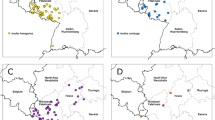Abstract
For ticks, phoretic behaviour using insects associated with vertebrates might offer an alternative strategy to host-seeking. Here we report for the first time the presence of immature stages of the most widespread tick species in Western Europe, Ixodes ricinus (Acari: Ixodidae), on three beetle species belonging to families Silphidae and Geotrupidae (Coleoptera). Specimens were collected while performing fieldwork surveys on insect diversity during the peak of tick’s questing behaviour, in July and August of 2009 and 2010. The collections took place in two Natural Parks, the Aiako Harria, Guipúzcoa in Northern Spain and Wellington Country Park, Berkshire, in England. The silphid beetle Nicrophorus vespilloides and the geotrupid Trypocopris pyrenaeus were collected from pig-carcasses and both carried nymphs of I. ricinus; the geotrupid Anoplotrupes stercorosus was carrying a tick larva while feeding on red deer dung. These findings revealed an unnoticed but common relation of ticks not only with decomposed animals but also with insect scavengers. We discuss the rationale of this phenomenon.

Similar content being viewed by others
References
Athias-Binche F (1994) La phorésie chez les acariens. Aspects adaptatifs et evolutifs. Castillet Publishing, Perpignan
Barandika JF, Hurtado A, García-Sanmartín J, Juste RA, Anda P, García-Pérez AL (2008) Prevalence of tick-borne zoonotic bacteria in questing adult ticks from Northern Spain. Vector Borne Zoonotic Dis 8:829–836
Bedick JC, Ratcliffe BC, Hoback WW, Higley LG (1999) Distribution, ecology, and population dynamics of the American burying beetle (Nicrophorus americanus Olivier (Coleoptera, Silphidae)) in south-central Nebraska, USA. J Insect Conserv 3:171–181
Camerik AM (2010) Phoresy revisited. In: Sabelis MW, Bruin J (eds). Trends in acarology: Proceedings of the 12th International Congress of Acarology. Springer, Amsterdam
Dautel H, Dippel C, Kämmer D, Werkhausen A, Kahl O (2008) Winter activity of Ixodes ricinus in a Berlin forest. Int J Med Microbiol 298(S1):50–54
Dobson AD, Taylor JL, Randolph SE (2011) Tick (Ixodes ricinus) abundance and seasonality at recreational sites in the UK: hazards in relation to fine-scale habitat type revealed by complementary sampling methods. Ticks Tick Borne Dis 2:67–74
Dumler JS, Barbet AF, Bekker CP, Dasch GA, Palmer GH, Ray SC, Rikihisa Y, Rurangirwa FR (2001) Reorganization of genera in the families Rickettsiaceae and Anaplasmataceae in the order Rickettsiales: unification of some species of Ehrlichia with Anaplasma, Cowdria with Ehrlichia and Ehrlichia with Neorickettsia, descriptions of six new species combinations and designation of Ehrlichia equi and ‘HGE agent’ as subjective synonyms of Ehrlichia phagocytophila. Int J Syst Evol Microbiol 51:2145–2165
Farish DJ, Axtell RC (1971) Phoresy redefined and examined in Macrocheles muscaedomesticae (Acarina: Macrochelidae). Acarologia 13:16–29
Flechtmann CHW, Baggio D (1993) On phoresy of hematophagous ectoparasitic Acari (Parasitiformes: Ixodidae and Dermanyssidae) on Coleoptera observed in Brazil. Int J Acarology 19:195–196
Guy EC, Stanek G (1991) Detection of Borrelia burgdorferi in patients with lyme disease by the polymerase chain reaction. J Clin Pathol 44:610–611
Guy E, Tasker S, Joynson DHM (1998) Detection of the agent of human granulocytic ehrlichiosis (HGE) in UK tick using polymerase chain reaction. Epidemiol Infect 121:681–683
Keirans JE (2009) Order Ixodida. In: Krantz GW, Walter DE (eds) A manual of acarology. Texas Tech University Press, Texas, pp 111–123
Kurtenbach K, Hanincová K, Tsao JI, Margos G, Fish D, Ogden NH (2006) Fundamental processes in the evolutionary ecology of Lyme borreliosis. Nat Rev Microbiol 4:660–669
Lesne P (1896) Moeurs du Limosina sacra Meig. Phénomènes de transport mutuel chez les animaux articulés. Origine du parasitisme chez les insectes diptères. Bull Soc Entomol Fr 1896:162–165
Mašán P, Krištofík J (1992) Phoresy of some Arachnids (Acarina and Pseudoscorpionidea) on synanthropic flies (Diptera) in the South Slovakia. Biologia 47:87–96
McNemee RB, Sames WJ, Maloney FA (2003) Occurrence of Dermacentor variabilis (Acari: Ixodidae) around a porcupine (Rodentia: Erthethizontidae) carcass at Camp Ripley, Minnesota. J Med Entomol 40:108–111
Mejlon HA, Jaenson TGT (1997) Questing behaviour of Ixodes ricinus ticks (Acari: Ixodidae). Exp Appl Acarol 21:747–754
Perotti MA, Braig HR (2009) Phoretic mites associated with animal and human decomposition. Exp Appl Acarol 49:85–124
Petrova AD, Basikhin PV (1993) The finding of larvae of the taiga tick Ixodes persulcatus (Parasitiformes: Ixodidae) on necrophagous piophilid flies (Diptera: Piophilidae) in the southern Yamal. Parasitology 27:427–429
Schotsmans EMJ, Denton J, Dekeirsschieter J, Ivaneanu T, Leentjes S, Janaway RC, Wilson AS (2012) Effects of hydrated lime and quicklime on the decay of buried human remains using pig cadavers as human body analogues. Forensic Sci Int 217:50–59
Sonenshine D (1993) Biology of ticks. Oxford University Press Inc, Oxford
Sukia XL, Serrano M, Rico MJL (1996) Catálogo abierto de espacios naturales relevantes de la Comunidad Autónoma del País Vasco. Servicio central de publicaciones del Gobierno Vasco, Vitoria-Gasteiz
Szabó MPJ, Castro MB, Ramos HGC (2007) Species diversity and seasonality of free-living ticks (Acari: Ixodidae) in the natural habitat of wild marsh deer (Blastocerus dichotomus) in Southeastern Brazil. Vet Parasitol 143:147–154
Acknowledgments
Thanks to Nigel Burnett, General Manager of Wellington Country Park for permitting access to the park and enabling us to collect samples. B.D.M. thanks the Basque Government, Department of Education, Language Policy and Culture, for supporting her research.
Author information
Authors and Affiliations
Corresponding author
Rights and permissions
About this article
Cite this article
Saloña-Bordas, M.I., Bahillo de la Puebla, P., Díaz Martín, B. et al. Ixodes ricinus (Ixodidae), an occasional phoront on necrophagous and coprophagous beetles in Europe. Exp Appl Acarol 65, 243–248 (2015). https://doi.org/10.1007/s10493-014-9867-y
Received:
Accepted:
Published:
Issue Date:
DOI: https://doi.org/10.1007/s10493-014-9867-y



